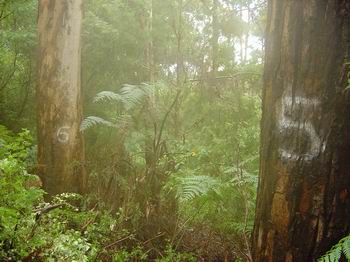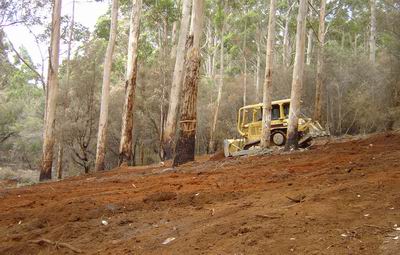Clearing an area of land to build your house on is a pretty important first step. You want to clear a good sized area, but not so big that you are pushing away what made you buy the block in the first place!
The first thing that I needed to do was to map out the area where the house, shed and water tank should be. I wanted levels, distances and distribution of existing trees. In thick forest it was goin to be hard. I thought about GPS, laser levels, theodolites; but in the end I sufficed with measuring tape, compass, some clear plastic tube full of water and a couple of marked sticks. A bit rough be adequate for the job.
I pegged in a datum point and set about measuring out 10m marks from the datum, banging in my measuring sticks (graduated at 10cm). My clear plastic tube, filled with water, might be at say the 5th graduation while the second stick at the 16th graduation. That meant the drop over the 10m was 110cm - because water stays levels in the tube of course.
I then carried on taking level samples throughout the building envelope and marking them off on a map, plotting lines of level as they became apparent.
Once I had a feel for the level of the land, I concentrated on locations of trees. I was only roughly accurate, approximating angles. I'd issue each tree a number and paint it on the side. I'd also guesstimate the canopy diameter - ie how far out the tree stretched. I decided I didn't want the house to be directly under a tree. I'd then measure between a few more trees, then start again from my datum point to try and not get too much cumulated error.
Eventually I'd gridded out 19 trees within the envelope, and had the distances scattered across about 6 pieces of paper, all slightly damp because it was raining ;) Once home I collated all the information on the computer and drew up a scale diagram. From the diagram it because pretty easy to see which trees needed to be removed. It didn't look quite the same as what I had previously submitted to shire, but it was all within the alloted building envelope.
All I needed to do now was get the area cleared.
Now through a fortunate set of circumstance I got in touch with the local fire brigade. In fact, lets talk about the fortunate circumstance, it's a useful anecdote.
Pemberton is a fairly small town, and the subdivision the block is in even smaller, about 3kms out of town. When I purchased the block I asked the real estate agent about who was doing the firebreaks. (Every year by December firebreaks have to be in place. It is a good thing.) The agent knew because she had been looking after the firebreaks for the owner, so I got in touch with him. When I was speaking with him about the firebreaks, he asked about what I was doing for burn-offs, I said I didn't know, he gave me the name of the fire captain. Locals usually have a good handle on what is going on...
I rang the fire captain and he told me he had received permission from CALM to do a burn on a whole strip of blocks that hadn't been burnt for around 20 years, mine being one of them. He had been asking for years, and been refused, but finally that year they permitted it. He then needed permission from me in writing if I wanted it done. For sure! Perfect timing, by burning the block now all the fuel in the underscrub could be eliminated, which would have been more painful if the house was already there.
I didn't see the main fire, but a week later when I was down there were still old fallen logs burning, still burning when I left. In fact they smouldered for about two months! The initial fire was not too hot which is good, it would have burnt too destructively, possibly killing Karri trees if it was. The idea is to burn all the leaf and stick forest litter on the ground and burn a good deal of old rotting fallen logs. In addition my "field" of the noxious weed blackberry was decimated. A lot of the underscrub didn't take well to the fire and simply died. Oh well, new ones will grow back. That's the life cycle of many bush plants - fire clears the way for seeds to shoot forth, they grow and seed themselves, later die and the next fire restarts the process.
So a big tip - before you start, get your local fire brigade to control burn your block. It might look a bit sad straight after but the forest loves it, gives it a real recharge to start growing again!
Another chap who I was put in touch with has a D6 bulldozer. He'd already done a quick walk around the block with me when I was marking it out, and about a week after the burn he rocked up with the dozer.
First he cleared out the scrub and pushed it down the slope into a big pile. Then he started pushing over the karri trees I had marked for clearing. (All the ones _not_ to be pushed over I clearly flagged with orange tape). I was pretty sad to see the karris fall, 9 in total ranging from some bubby 20cm diameter ones up to two big 900mm ones which had to be cut down later - a D6 can't push that size tree over.
After four and a half hours he'd cleaned up the immediate area around the house, and been down onto the flat area that was perviously blackberry and cleaned some of that up too. I was very pleased to find that a good deal of it was not swampy at all like I had previously expected.
The work came in at around $1000 and I was very happy with it. He drove the bulldozer like it was an extension of his body. I'd recommend G&S Roberts Contracting to anyone in the area who needed some dozer work.
Now the area is clear it is much easier to see what is going on...including maybe a rethink of where the shed and water tank will be!
It was about this time that I decided the house needed to be as close to the boundary as allowed, firstly to be as far up the hill as possible and secondly because the further you went down the hill, the slopier it got. So much for my original plan!
I spoke to the Shire and sent them a new plan. In some respects, not a good idea. It opened up a can of worms...
Firstly, the Shire shouted "variation!" as the building envelope was going to be moved, albeit about 5m. That stung me another $200. The variation then had to go through neighbour comment. Meantime, by moving further up the slope I was getting very close to a rather large karri on the neighbours block. In fact, it had a really really big bough hanging out far enough to be a threat to the house. I also then proposed that the bough be taken down.
I got in tough with Gavin from Lop'n'Drop in Manjimup. He came recommended as the man for the job, and after seeing him at work I further recommend him. To cut a long story short, he recommended the whole tree be felled. Why?
This particular tree, and a number of trees in the area, had regrown from stumps from the original clear fell of the area - in about 1930 I was told. When a tree grows back from a stump, it usually does so from one side - so the roots on the other side of the stump die, and the tree re-establishes itself with roots only on one side.
So the tree had grown back, but without a full 360° root system. And a large tree too. The bad part is that without a proper root system, a big wind hitting it could topple it over, in the direction of where it regrew from - directly on my house!
Now the idea removing this tree upset my neighbour, being his tree, and he objected to the variation. This means that the council had to table it at their next council meeting. Fortunately for me a Shire Ranger inspected it and gave it the "dangerous" label, and my neighbour didn't actually give a reason for his objection other than "I don't want any trees on my block touched." I spoke with him several times, very politely, I think I must have broken him through sheer persistence. Eventually the council decided I could remove it and he agreed in the end.
Watching Gavin drop it was amazing. Firstly he scaled the tree with spikey boots and a bit of rope to take off two big branches, so as it fell it wouldn't hurt too much of the surrounding trees. He would have been 40m up easy. My knees get weak after about 2m...
With careful precision he made the felling cuts, and dropped the tree exactly where he planned through a small gap in the forest. Love your work.
So now, with all the necessary trees out of the way, approval _again_ from the council for my new proposed site, it was time to get the kit down!










